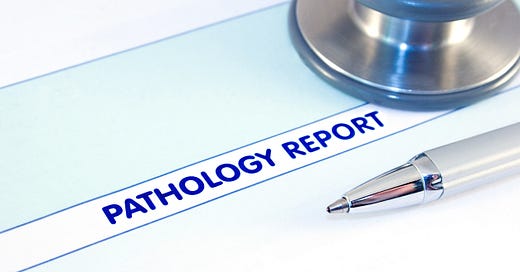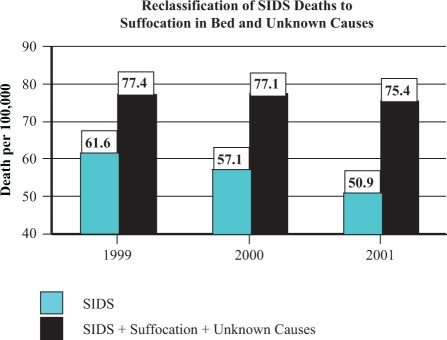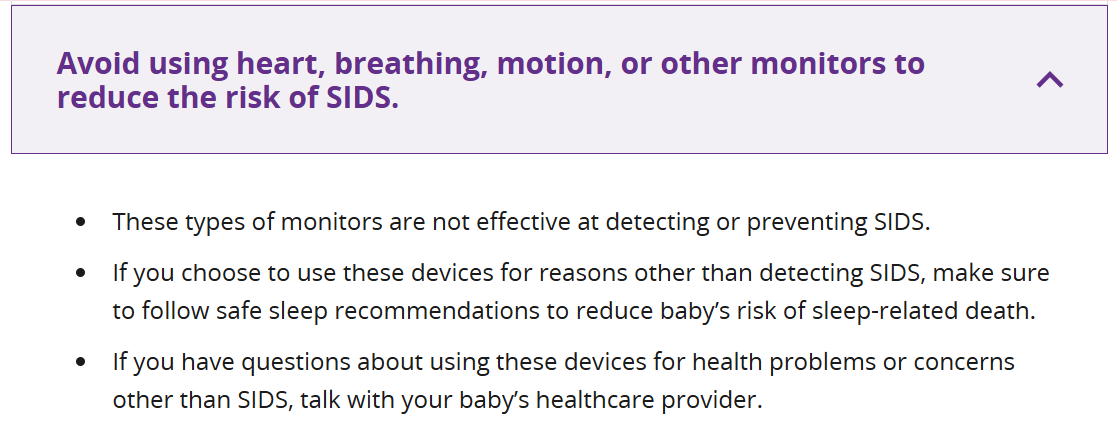Telltale signs of SIDS: 90% of lab reports show immune activation - Part 2
'Mainstream approaches to the problem are flawed at a fundamental level'
In Part 1 of this article, we examined the autopsy findings in sudden infant death syndrome (SIDS) cases and the refusal of health authorities to consider vaccines as a possible cause. Now, we take a closer look at additional data and research that further challenge the mainstream narrative claiming the cause of these infant deaths is unknown.
Blame the parents
Despite the evidence of serious internal damage found upon autopsy in SIDS deaths, the public was told that the way parents have been putting their children to bed for centuries is responsible for the deaths. The “Back to Sleep” campaign was implemented in 1992 as a means of preventing SIDS, as reported by Miller and Goldman.
In 1992, to address the unacceptable SIDS rate, the American Academy of Pediatrics initiated a ‘Back to Sleep’ campaign, convincing parents to place their infants supine, rather than prone, during sleep.
It was claimed that once parents started putting their babies to sleep on their backs the incidence of SIDS dropped.
However, Miller and Goldman observed that, as SIDS declined, other causes of death, reported under various other International Classification of Diseases (ICD) codes, increased. This phenomenon was not unique to the U.S.; Australia reported an exact inverse correlation.
From 1992 to 2001, the postneonatal SIDS rate dropped by an average annual rate of 8.6%. However, other causes of sudden unexpected infant death (SUID) increased. For example, the postneonatal mortality rate from ‘suffocation in bed’ (ICD-9 code E913.0) increased during this same period at an average annual rate of 11.2%. The postneonatal mortality rate from ‘suffocation-other’ (ICD-9 code E913.1-E913.9), ‘unknown and unspecified causes' (ICD-9 code 799.9), and due to ‘intent unknown’ in the External Causes of Injury section (ICD-9 code E980-E989), all increased during this period as well. (In Australia, Mitchell et al. observed that when the SIDS rate decreased, deaths attributed to asphyxia increased. Overpeck et al. and others, reported similar observations.)
They provided the following graph of SIDS vs SUID from 1999 to 2001, demonstrating that as SIDS rates were shown to have declined from 61.6 to 50.9 deaths per 100,000, the all-cause mortality, SUID, remained relatively stable.
Back-to-sleep - a quick fix
According to Wikipedia, the back-to-sleep campaign was initiated because it was found that babies who sleep on their stomachs sleep more soundly and are more difficult to arouse.
[The back-to-sleep campaign] was based on the epidemiology of SIDS and physiological evidence which showed that infants who sleep on their back have lower arousal thresholds and less slow-wave sleep (SWS) compared to infants who sleep on their stomachs. Thus, these infants are more easily awakened. However, the arousal thresholds have been shown to be higher during SWS causing infants to be less easily awakened.
It was theorized that infants who are more difficult to arouse would not wake up easily if they stopped breathing. They surmised that those babies have a brain stem defect that would make it harder for them to wake up and consequently be at a greater risk of death.
[I]t is theorized that some infants have a brain-stem defect which increases their risk of being unable to arouse from SWS (also called deep sleep) and therefore have an increased risk of SIDS due to their decreased ability to arouse from SWS.
Safe to sleep - even more ways to blame parents
In 1994, the campaign was renamed Safe-to-Sleep, and safe sleeping conditions were promoted in addition to back sleeping.
Since "Safe to Sleep" was launched in 1994, the incidence of SIDS has declined by more than 50%.
Despite the claimed decrease in SIDs of 50% after renaming the campaign, the incidence of other causes of death increased, requiring the broadening of safe sleeping requirements.
However, there has been a rise in infant sleep-related suffocation events. Consequently, the campaign has broadened its goal to focus on safe sleep conditions and further preventative measures.
The NIH’s (National Institutes of Health’s) Eunice Shriver Kennedy National Institute of Child Health and Human Development (NICHD) promoted these additional measures, which include putting babies to sleep with a pacifier, breastfeeding, keeping their crib clear of any toys and bedding, and providing a toxin-free environment among other measures.
A Circle of Mamas, in its review of SIDS, observed that despite parents doing more of the things they are told will prevent SIDS, the number of SIDS cases remains essentially the same.
If fewer infants are exposed to the classical ‘SIDS risk factors’, why are the same amount of infants dying every year? There are so many parents who do everything ‘right’, it doesn’t make any sense. Technically speaking, the SUID rate increased from 2014 to 2015. What are we missing?
Hiding the internal damage
Health authorities claim that SIDS has no known causes, but they fail to disclose the telltale signs of the condition. As a result, they avoid having to explain how sleeping on the back, using a pacifier, or other preventive strategies could address the congestion, fluid buildup, inflammation, and thoracic bleeding found in most SIDS autopsies—key indicators of the condition.
These signs of internal damage suggest underlying issues with identifiable causes. Such internal damage cannot be addressed by the risk reduction methods promoted by the NICHD’s Safe to Sleep® campaign to prevent SIDS.
SIDS in awake infants
Adelaide Medical School faculty member Paul Nathan Goldwater noticed the disconnect between the observed physiological findings in SIDS autopsies and the proffered solutions. In an April 2022 Frontiers in Pediatrics, Pediatric Infectious Diseases article titled “The Science (or Nonscience) of Research Into Sudden Infant Death Syndrome (SIDS),” he calls out the scientific establishment for ignoring the findings in SIDS cases. He makes the observation “that mainstream approaches to the problem are flawed at a fundamental level.”
One flaw is the criterion that SIDS must occur when the infant is asleep. SIDS, he writes, can happen when babies are awake, and the current criteria would exclude those cases. This is the reason why researchers have focused on events during sleep and arousal mechanisms, so most investigations do not consider risk factors and autopsy findings.
With very few exceptions, the results of these investigations do not refer to epidemiological risk factors or the gross pathological findings of SIDS. Therefore, these findings are unsupported in obvious ways. Death during sleep is not a prerequisite for diagnosing SIDS/SUID: cases occur in awake infants, although the San Diego definition [of SIDS] with its “during sleep” restriction would exclude these cases.
He also points out that there is no way of knowing that the infant was asleep.
Such restriction is only academic, as proof of being asleep cannot be ascertained.
“Science or Nonscience” of SIDS research
Goldwater raises the issue of autopsy findings, which have been ignored in favor of “current dogma,” which “purports that the gross pathology of SIDS is unremarkable.” He calls this a fundamental error.
This is fundamentally erroneous. As with the investigation of adult deaths the autopsy remains the mainstay for proper diagnosis. The same applies to the investigation of SIDS. Standardized autopsy protocols go some way in improving the investigation of sudden deaths but these, unfortunately, are not universally applied.
He further notes that 90% of the SIDS autopsies have the same pathologies.
In regard to SIDS, where autopsies have been conducted by pediatric pathologists, it is remarkable that the pathological findings are very consistent and can be applied to approximately 90% of cases.
These include the ones noted above as well as many others. Laboratory reports from SIDS autopsies reveal elevated pro-inflammatory cytokines (such as IFN-alpha, TNF, and IL-6), increased clotting markers like D-dimer, and signs of circulatory shock, suggestive of an overactive immune or inflammatory process. This immune response could impair the body's ability to regulate vital functions, such as breathing, potentially increasing the risk of SIDS.
It is a striking observation that such immune and inflammatory responses can be directly linked to the one cause that has been dismissed: vaccines. Even more compelling is that most babies are vaccinated at two months with the DTaP vaccine, which would make it a common and temporal factor among infants. Yet, health authorities have declared that vaccines don't cause SIDS, effectively quashing any research that might demonstrate such a link. This is a highly plausible expectation since the vaccines themselves contain viral and bacterial antigens that trigger immune responses in the infant. The previous DTP and current DTaP vaccines include three different antigens that the undeveloped immune system must simultaneously contend with.
Cotwatch monitor links vaccines to SIDS
Research by Viera Scheibner, as reported by this Substack, supports a potential correlation between vaccines and autopsy findings in SIDS cases. The Cotwatch monitor was developed by her then future husband in 1985. The monitor, a pad under the mattress, recorded an infant’s breathing as it lay or rolled around in the crib, picking up instances of shallow breathing common to many infants following the two-month DTP vaccines.
Cotwatch sounded an alarm when there were pauses in infants’ breathing and low-volume breathing. When they first gave new parents monitors nothing happened for two months and then parents reported that alarms started going off. When she asked what had happened around that time, parents said their child had been vaccinated. They had also given the parents forms to fill out (before they developed the computer print-out) and when she reviewed them she saw a pattern emerge. . .
When you have a pattern that is significant because it means causal link. The evidence of the link, causal link, between vaccination and what happens afterwards, the reactions, is in clustering of the alarms.
However, when they brought their findings to the scientists and pediatricians who were researching SIDS, she says they were met with hatred. She delisted the monitor from the Australian Therapeutic Goods Agency after her husband passed away in 1994.
Could the causal link between SIDS and vaccines, which Scheibner’s analysis of the Cotwatch monitor data revealed, and which she and her husband raised with SIDS researchers, have influenced authorities to ultimately discourage the use of breathing monitors for infants? Were there too many parents using other monitors that showed the same link? The Back to Sleep campaign was renamed the Safe to Sleep campaign in 2012 with broader recommendations since the reduction in SIDS cases was plateauing. The NICHD's Safe to Sleep program includes a recommendation against using breathing monitors as part of the 'Safe to Sleep' campaign (screenshot below). This is significant, as such monitors may help detect early signs of respiratory distress, and discouraging their use can potentially hinder early detection of breathing abnormalities, which Scheibner identified as a common warning sign in SIDS cases. The recommendation is all the more suspect since the campaign did not rule out using these monitors for reasons other than detecting SIDS. This directive could potentially suppress data challenging the prevailing narrative that vaccines don't cause SIDS.
This Substack also reported that two detectives who discovered during their investigations that vaccinations are the main common event preceding SIDS were silenced, with one being prosecuted for making the connection. Considering that an investigation of the scene of death is required for a SIDS determination, this is a further anomaly in what should be a thorough examination of a presumably elusive diagnosis.
An effort to suppress evidence; a violation of trust
Is there a concerted effort to systematically suppress any consideration of vaccines as a cause of SIDS, to the extent of disregarding clear autopsy signs of internal damage and the findings of police investigations?
Health authorities such as the CDC that assert that the cause of SIDS is unknown, despite 90% of autopsies showing the same pathological findings, and promoting unsupported preventive measures, are not just promulgating mis/disinformation, but are violating the trust the public places in its health authorities.
An upcoming article will continue to examine the evidence for a potential connection between SIDS and vaccines.
Related articles:
The information contained in this article is for educational and information purposes only and is not intended as health, medical, financial, or legal advice. Always consult a physician, lawyer, or other qualified professional regarding any questions you may have about a medical condition, health objectives, or legal or financial issues.







